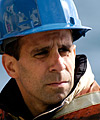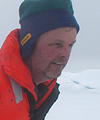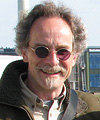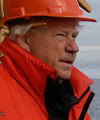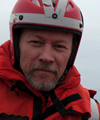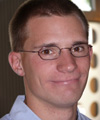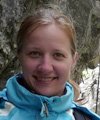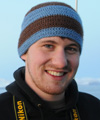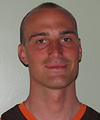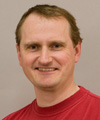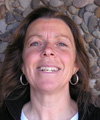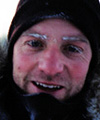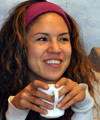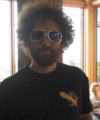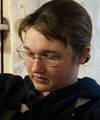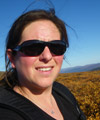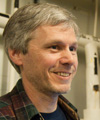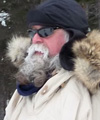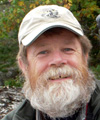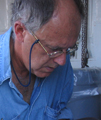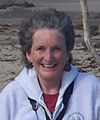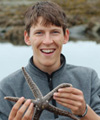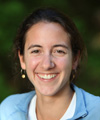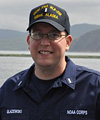Please note: You are viewing
the unstyled version of this website. Either your browser does not support CSS
(cascading style sheets) or it has been disabled. Skip
navigation.
Chief Scientist Woods Hole Oceanographic Institution, Massachusetts, USAI am the Chief Scientist, which means that I coordinate all of the science activities for this cruise.
Mooring technician Woods Hole Oceanographic Institution, Massachusetts, USAMy primary job on the Healy will be leading the deck operations for all the mooring deployments and recoveries. I have worked at Woods Hole Oceanographic Institution for over 33 years, my background is in the design of prototype mooring systems, development of new mooring technologies and at-sea operations.
VMADCP/Instrument tech Woods Hole Oceanographic Institution, Massachusetts, USAI am an instrument guy. My main job is to babysit a shipboard ADCP, an acoustic current meter. It measures water velocity by listening to a change in the tone of the sound it sends out (called "Doppler effect"). I will also prepare battery-operated instruments for measuring temperature and salt content that we will deploy in the ocean on tripods, and on long cables attached to bottom anchors (called "moorings").
Mooring technician University of Alaska-Fairbanks, Alaska, USAAs a "mooring technician" for the University of Alaska, I am primarily concerned with the gathering of data from the ocean using moored instruments. To get the data I do a lot of battery changing and scraping of barnacles. This summer, as the ice receeded we recovered and/or deployed nine moorings between the Pribilof and St Lawrence Islands, eight in the Bering Straight, six off of Wainwright and six west and north of Barrow (some of the latter from the Healy on this cruise).
CTD technician Scripps Institution of Oceanography, California, USAI am contracted to the Healy by the Coast Guard to provide science support. My primary responsibilities are centered around the CTD/Rosette system, MET system, and Science Seawater system. I have worked for Scripps Institution of Oceanography as a Senior Electronics Technician for 19 years, after serving 14 years in the U.S. Submarine Service as an Electronics Tech and Navy Diver. At Scripps, I am part of the Shipboard Electronics Group which is a department of the Shipboard Technical Support Group.
CTD watchstander Massachusetts Institute of Technology / Woods Hole Oceanographic Institution Joint Program, Massachusetts, USAI will be assisting with the collection of several vertical sections of temperature, salinity, velocity and other properties throughout the water column. These shipboard, spatially well-resolved measurements will help to increase our understanding of the flow along the shelfbreak (the place roughly 100m deep where the water depth starts to quickly increase). I am particularly interested in the structure of this flow during summer time (including September) when the water is quite warm compared to sea-ice melting temperatures.
CTD watchstander I am an undergraduate student and will get the chance for my very first scientific cruise. I am hoping to learn a lot more about oceanography and be able to assisting with deck work and collection of data.
CTD watchstander University of East Anglia, Norwich, UKI will be assisting in the measuring of the circulation and water characteristics of the region during the cruise. I will also be filming aboard the Healy and producing a documentary about the cruise on our return.
CTD watchstander Humboldt State University, California, USAI have just completed an undergraduate degree in Oceanography with minors in Applied Mathematics and Spanish at Humboldt State University, Arcata, CA. I will be assisting with deck work and collection/processing of the shipboard measurements as part of a Marine Advanced Technology Education (MATE) internship.
Mooring technician Applied Physics Laboratory, University of Washington, Washington, USAThe oceans breathe by exchanging gases, including oxygen and carbon dioxide, across the air-sea interface. Craig and colleague Jamie Morison (APL/UW) are studying the impacts of reduced summer sea ice extent in the Arctic on air-sea gas exchange and biological productivity using novel dissolved gas sensors on a mooring.
Marine mammal technician National Oceanic and Atmospheric AdministrationI'll be picking up and deploying moored hydrophones, or underwater microphones, that are continuously recording the sounds of the sea. Our main focus is to document the sounds of marine mammals, including bowhead whales, belugas, seals and even walrus. Most of these instruments are designed to record for a year, so we are very anxious to get the data back and start recording again. I will also be collecting visual observations of the marine mammals we see.
Marine mammal technician University of California San Diego, California, USAJosh studies the sounds of marine mammals at the Whale Acoustics Laboratory of the Scripps Institution of Oceanography. During this expedition, he will be servicing three High-frequency Acoustic Recording Packages (HARPs) that sit on the seafloor and record sound continuously for up to a year. This data is analyzed to help understand how and when species of marine mammals use the habitat within the study area.
Community observer Barrow, Alaska, USAI recently finished up my undergraduate studies at Dartmouth College in Environmental Studies. My senior project included examining the history of OCS lease sales in the Beaufort and Chukchi Seas, and taking part in the COP 15 discussions on the topic of climate change in Copenhagen last December. I found the topic to be rather interesting, so I look forward to the opportunity of fulfilling the role of the Community Observer. I grew up in Barrow and Fairbanks, Alaska and will be applying to graduate schools after the cruise.
Bird observer US Fish and Wildlife Service and Moss Landing Marine Labs, CaliforniaI am a seasonal employee for the US Fish & Wildlife Service, and a graduate student in seabird ecology at Moss Landing Marine Labs in California. My role aboard the Healy is to survey seabirds while we transit between stations, and collect data about their distribution and foraging patterns. Seabirds are excellent indicators of ecosystem health and prey productivity, and by documenting their abundance patterns we accumulate valuable information about the environment.
Water chemistry University of Alaska, Fairbanks, Alaska, USAAt the start of this cruise, I will be in the third year of my PhD research at UAF. On this particular cruise, I will be collecting water samples from the CTD in order to measure carbonate chemistry in the Arctic, focusing primarily on dissolved carbon and seawater pH.
Water chemistry University of Alaska, Fairbanks, Alaska, USAI am the Laboratory Technician for the Ocean Acidification Research Center at UAF. I will be collecting samples from the CTD to better understand the chemistry of seawater in the Arctic.
Microstructure Woods Hole Oceanographic Institution, Massachusetts, USAI will be acquiring oceanic microstructure (turbulence) data using a special profiler capable of measuring small fluctuations in velocity and temperature. This data will tell us how the water is stirring and mixing at small scales. These measurements are useful in understanding how heat and nutrients are transported vertically in the water column. In addition, we need to understand the magnitude and underlying causes of these small scale motions if we are to accurately predict large-scale ocean circulation.
Science support University Corporation for Atmospheric Research, Colorado, USAI'm on contract through LDEO to support the Healy underway science systems and assist the scientists in the use of the systems and data generated by these systems. I'm also maintaining a web-based interactive mapping server that I've developed over the last few seasons. This server allows the scientists to view the data from many of the underway systems in near real-time and is the principle interface for planning and operational decision making.
Science support Lamont-Doherty Earth Observatory of Columbia University, New York, USAI'm a real-time instrumentation guy. My group is funded by the National Science Foundation to provide science instrumentation, technical support, and planning on Healy.
Science support Woods Hole Oceanographic Institution, Massachusetts, USAI do science support. What that means is I watch the shipboard systems' data come in and make sure they are working properly. I also run the bathymetry systems. At the end of the trip I provide the science team a summary of the data collected by the shipboard systems during the cruise.
Education and Outreach Writer/playwright, Manhattan, New York, USAI'll be writing daily journals to our website as outreach about the science and life aboard an icebreaker. Learn more about my work at dallasmurphy.com.
Education and Outreach Freelance photographerI will be taking photographs to document the scientific activity as well as Arctic wildlife, seascapes, and daily life aboard the Healy.
Education and Outreach Retired Classroom Teacher, Massachusetts, USAI will be researching the answers to the questions from our School Partners, facilitating the audio conference with each school and taking in all the new experiences of this scientific adventure.
Stanford University Stanford, California, USAMicroscopic phytoplankton form the base of all Arctic marine food webs. As primary producers, they can create food from only sunlight and the inorganic chemicals found in water, which eventually feeds all of the larger, more familiar species, including whales, walrus, and polar bears. I am keen on understanding the way that this exceptionally important group of organisms may respond to climate change. For example, warming and sea ice loss are likely to affect the timing of the spring phytoplankton bloom, the rapid growth that occurs when ice pulls back each spring. Such a shift could have cascading impacts up the food chain, as many species time their migrations and reproduction to match this very productive period, and they may not be able to adapt to changes in timing. In addition, phytoplankton use carbon for growth, effectively removing CO2 from the atmosphere. With more ice-free habitat for phytoplankton growth, can we expect the Arctic to become a greater CO2 sink, thus providing a negative feedback on climate change? Such questions are at the heart of understanding the structure and function of the Arctic ecosystem.
Ice analyst I'm a graduate student at the University of Washington studying physical oceanography, more specifically sea ice and remote sensing. On this cruise, I'll be deploying buoys for the International Arctic Buoy Programme, and helping with the sea ice observations and Marine Mammal Watch.
Ice analyst National Oceanic and Atmospheric AdministrationI'll be assisting as an ice observer, and gaining experience on this particular ice breaker standing bridge watches and learning the command of the vessel.Last updated: September 23, 2010 | |||||||||||||||||||||||||||||||||||||||
Copyright ©2007 Woods Hole Oceanographic Institution, All Rights Reserved, Privacy Policy. | |||||||||||||||||||||||||||||||||||||||
